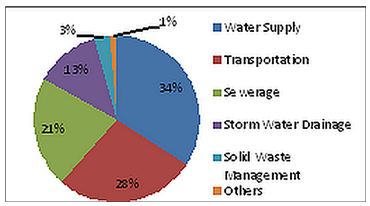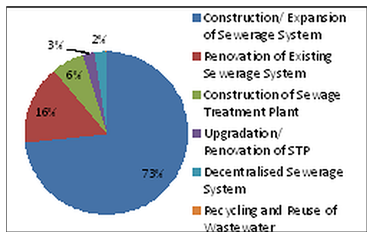JNNURM and Environmental Sustainability
The Jawaharlal Nehru National Urban Renewal Mission was launched in 2005 as India’s urban flagship programme to close investment gaps in urban infrastructure, and to implement reforms for better urban management. This column assesses the extent to which sustainability concerns are addressed by the programme, and makes recommendations in this regard.
The next few decades will be critical in shaping urban infrastructure in India as investments flow to cities for expanding their infrastructure networks. India faces a unique challenge of closing the deficit in urban infrastructure and services, while at the same time making a transition to a more sustainable path. However, this deficit may well be a boon in disguise, as it could serve as an opportunity to leapfrog to more sustainable, less energy and resource-intensive forms of infrastructure. In this context, the study looked at the Jawaharlal Nehru National Urban Renewal Mission (JNNURM) - India’s urban flagship programme, launched in 2005 and with an estimated investment of Rs. 120,000 crores ($19.3 billion) approximately, as it presented the maximum opportunity to influence the nature of urbanisation in India. The study examined evidence with regard to sustainability concerns and if and how these were addressed in the programme (Wankhade, 2013).[1]
JNNURM: Closing investment gaps in urban infrastructure
After decades of neglect of the urban sector, the Government of India identified the lack of adequate infrastructure as one of the road blocks to urban development, and aimed to close the investment gaps in urban infrastructure through JNNURM. While the majority of funding was to be from the Government of India, state governments and Urban Local Bodies (ULBs) were expected to contribute to the investments. It has to be noted here that JNNURM was not envisaged merely as an investment programme. It was linked to a set of reforms that would improve urban management and catalyse further investments. The major sectors included under JNNURM are water supply, sewerage, transport, drainage, heritage and inner city renewal. Figure 1 shows that the maximum investment has been made in water supply, followed by transportation. The other sectors that have seen considerable investment are sewerage and storm water drainage.[2]
Figure 1. Utilisation across sectors

Source: Analysis of data sourced from http://jnnurm.nic.in/, September 2012
The study
To understand whether environmental sustainability has a place in JNNURM, the programme was examined at multiple levels for sustainability markers. This included a perusal of the various brochures, guidelines and toolkits provided by the Government of India; and secondary review of 20 City Development Plans (CDPs). We also did a case study of Nanded, a JNNURM City in Maharashtra, to contextualise our inquiry. Based on a literature review, a framework for environmental sustainability was developed. The broad themes of the sustainability framework included:
a) Environmental (sustainability of source/ sink, resource use, waste)
b) Design and Technology (performance, efficiency, adaptability)
c) Social and Public Health (equity, reduction in diseases)
d) Economic (Per Capita Investments, operations & maintenance (O&M))
e) Process (inter-linkages with other sectors, integration, capacity building, monitoring and evaluation)
Findings and recommendations
Detailed analysis was done for each sector, and examined at multiple levels. The key findings and recommendations were:
1. Incorporation of limited dimensions of sustainability and lack of systemic understanding: The appreciation of environmental sustainability (at all levels) was limited to certain issues like O&M and certain forms of pollution. While these concerns are valid, they constitute a small and partial subset of sustainability.
Further, most of the concerns that were raised were on the waste side, and dealt with visible issues like pollution. The review of CDPs and discussions with officials revealed a lack of systemic understanding of sustainability. As a result, the solutions proposed often did not address the underlying root causes of environmental damage. For example, the solution to air pollution was suggested to be the use of fuel efficient cars, instead of restructuring the transportation system towards public transport and Non-Motorised Vehicles.
Recommendation: Consider the whole range of environmental issues - Cities should take into account the entire gamut of environmental issues and impacts, right from resource use and efficiency of the system to the disposal of wastes. For example, in case of water, it is not sufficient to only take issues of waste water and pollution into consideration; one needs to consider intensity of water use, and plan accordingly at the regional level.
2. Technology fixation/ Missed opportunity to leapfrog on to a more sustainable path: While coverage is a clear priority at all levels, the coverage is proposed to be achieved by certain methods and technologies. There is often a focus on specific strategies, methods and technologies rather than larger sustainability goals. For example, the goal is often specified as 100% coverage of the city by sewers, instead of access to safe sanitation facilities for all and the full cycle of treatment. Incidentally, the JNNURM recognises sewerage as a sector, and not sanitation. Figure 2 shows that most of the money has gone in conventional sewerage network, and treatment plants, without commensurate priority to universalising sanitation access or 100% treatment.
Figure 2. Utilisation in sewerage sector

Source: Analysis of data sourced from http://jnnurm.nic.in/, September 2012.
Selection of particular technologies and systems may foreclose different pathways to sustainability. Thus, selection of appropriate and context specific technology and systems, and bundling of different technologies can be seen as a key element to urban sustainability.
Particular systems also have certain costs, capital and operations attached to them. To address the issue of service provisioning innovatively might also represent a chance to bring down these costs. For example, the entire discussion on O&M focuses on raising sufficient funds to meet O&M costs, rather than thinking through whether these expenses can be brought down in the first place, by opting for a different capital mix.
Recommendation: Explore, promote and encourage a wide range of technological systems - It seems that cities are foreclosing certain pathways by prematurely choosing particular technologies; and these technologies might or might not be best for a particular city. There might be limited capacity and resources with the ULB to explore and pilot different technologies. Hence the government needs to actively promote different technologies and build capacities for ULB to do so.
3. Strong reflection of national policies and agendas at city level: Since JNNURM allows each city to set its own priorities and plan accordingly; one would have expected to see differences in priorities, choice of technology and processes. However, the review of CDPs and our case study demonstrates that there appears to be a drill-down of discourse from the national level to the planning and implementation at city level. For example, sustainability has been associated with O&M in JNNURM brochures, and one finds this narrow association in majority of CDPs. Discussions with various officials in Nanded also demonstrated that sustainability was associated with O&M. There are several other examples. This often means that priorities and choices are not reflective of unique constraints, challenges and opportunities present in the city.
Recommendation: Guidelines at national level to emphasise outcomes and process: The above discussion highlights two concerns: national discourses and policies have a strong influence on city planning, and secondly, there is a tendency to confuse certain outcomes with specific systems/ solutions. Given this, it is imperative that the national policies/ guidelines emphasise broad outcomes, rather than highlight particular strategies or technologies.
4. Lack of integrated inter-sectoral and spatial planning: There is limited evidence of integrated planning that examines linkages between sectors, and with spatial planning. While certain linkages, for example, between water supply and sewerage are sometimes recognised, in general, planning for each sector is done in isolation. There is also almost no linkage between spatial planning (often implemented through Master Plans) and infrastructure planning.
Recommendation: Build capacities for integrated planning - The ULB or other concerned government agency need to have/develop capacity for integrated planning. While different technologies or methods might be used for different parts of the cities, these need to come together seamlessly at the city level.
5. Lack of integration with other programmes/ guidelines: There is limited reference and integration with other policies, programmes and acts. The exception is the recognition of National Urban Transport Policy. But the guidance laid down in the National Urban Sanitation Policy and Municipal Solid Waste Management Rules have not been followed, even though both of these address the issue of environmental sustainability centrally. Hence, it is clearly not sufficient to stipulate the concerns in specific policies – there is a need to integrate with specific programmes.
Recommendation: Reforms to be linked to Infrastructure Investments - One of the ways in which the JNNURM provided for instituting sustainability considerations was through linking reforms to investments. However, it appears that infrastructure investments are being undertaken without full compliance to reforms. In the successor programme to JNNURM hence, there is a case to a) incorporate the above concerns appropriately in the principles and guidelines, and b) incorporate sustainability considerations in project implementation processes on ground, rather than general reforms.
Notes:
- There are two main sub-missions under JNNURM: Urban Infrastructure and Governance (UIG) and Basic Services for the Poor (BSUP). This study examined only the Urban Infrastructure and Governance (UIG) sub-mission, and all the analysis presented in the column refers only to the UIG sub-mission.
- Figure 2 shows the break-up of utilisation reported by the cities for various projects. Since it is difficult to estimate total investments, utilisation has been used as a proxy for total investments.
Further Reading
- Wankhade, K. (2012), “JNNURM: An Opportunity for Environmentally Sustainable Urbanisation”, IGC Working Paper. https://www.theigc.org/publications/working-paper/jnnurm-opportunity-sustainable-urbanisation
- Swilling M., Robinson B., Marvin S. and Hodson M. (2013), ‘City-Level Decoupling: Urban resource flows and the governance of infrastructure transitions’, A Report of the Working Group on Cities of the International Resource Panel, UNEP.

